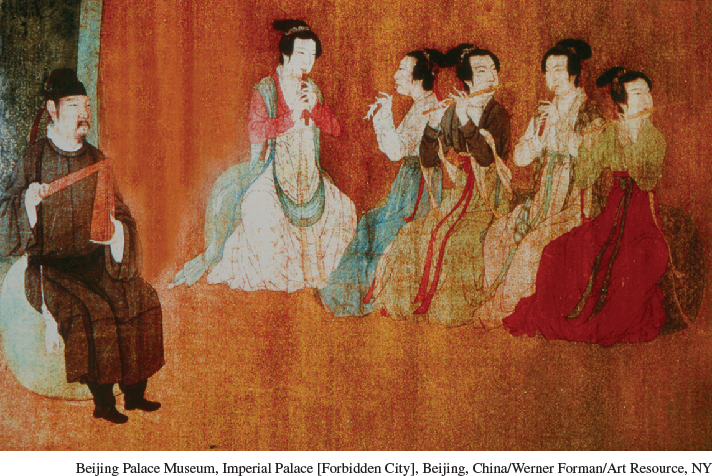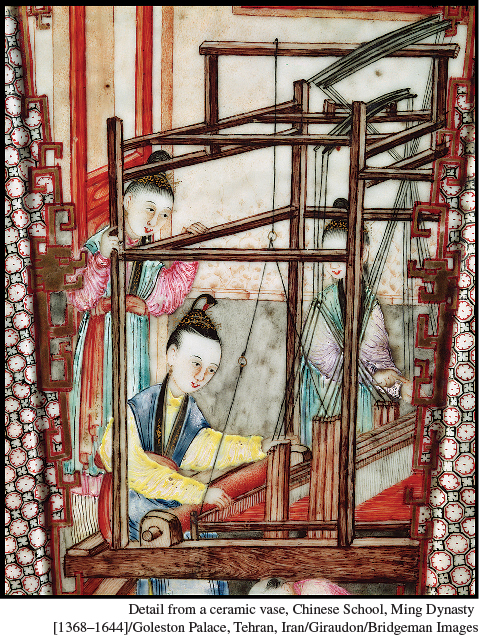A Changing Patriarchy: The Case of China
AP® EXAM TIP
Generally speaking, patriarchy became stronger in China as each dynasty’s government strengthened. Knowledge of this pattern may help you on the AP® exam.
As Chinese civilization took shape during the Han dynasty, elite thinking about gender issues became more explicitly patriarchal, more clearly defined, and linked to an emerging Confucian ideology. Long-
Guided Reading Question
▪CHANGE
In what ways did the expression of Chinese patriarchy change over time, and why did it change?
What this view meant more practically was spelled out repeatedly over the centuries in various Confucian texts. Two notions in particular summarized the ideal position of women, at least in the eyes of elite male writers. The adage “Men go out, women stay in” emphasized the public and political roles of men in contrast to the domestic and private domain of women. A second idea, known as the “three obediences,” emphasized a woman’s subordination first to her father, then to her husband, and finally to her son. “Why is it,” asked one text, “that according to the rites the man takes his wife, whereas the woman leaves her house [to join her husband’s family]? It is because the yin is lowly, and should not have the initiative; it proceeds to the yang in order to be completed.”17
The Chinese woman writer and court official Ban Zhao (45–116 C.E.) observed that the ancients had practiced three customs when a baby girl was born. She was placed below the bed to show that she was “lowly and weak,” required always to “humble herself before others.” Then she was given a piece of broken pottery to play with, signifying that “her primary duty [was] to be industrious.” Finally, her birth was announced to the ancestors with an offering to indicate that she was responsible for “the continuation of [ancestor] worship in the home.”18

Yet such notions of passivity, inferiority, and subordination were not the whole story of women’s lives in ancient China. A few women, particularly the wives, concubines, or widows of emperors, were able on occasion to exercise considerable political authority. Several others led peasant rebellions. In doing so, they provoked much antifemale hostility on the part of male officials, who understood governance as a masculine task and often blamed the collapse of a dynasty or natural disasters on the “unnatural” and “disruptive” influence of women in political affairs. Others, however, praised women of virtue as wise counselors to their fathers, husbands, and rulers and depicted them positively as active agents.
Within her husband’s family, a young woman was clearly subordinate as a wife and daughter-in-law, but as a mother of sons, she was accorded considerable honor for her role in producing the next generation of male heirs to carry on her husband’s lineage. When her sons married, she was able to exercise the significant authority of a mother-in-law. Furthermore, a woman, at least in the upper classes, often brought with her a considerable dowry, which was regarded as her own property and gave her some leverage within her marriage. Women’s roles in the production of textiles, often used to pay taxes or to sell commercially, made a woman’s labor quite valuable to the family economy. And a man’s wife was sharply distinguished from his concubines, for she was legally mother to all her husband’s children. Furthermore, peasant women could hardly follow the Confucian ideal of seclusion in the home, as their labor was required in the fields. Thus women’s lives were more complex and varied than the prescriptions of Confucian orthodoxy might suggest.

Much changed in China following the collapse of the Han dynasty in the third century C.E. Centralized government vanished amid much political fragmentation and conflict. Confucianism, the main ideology of Han China, was discredited, while Daoism and Buddhism attracted a growing following. Pastoral and nomadic peoples invaded northern China and ruled a number of the small states that had replaced the Han government. These new conditions resulted in some loosening of the strict patriarchy of Han dynasty China over the next five or six centuries.
The cultural influence of nomadic peoples, whose women were far less restricted than those of China, was noticed, and criticized, by more Confucian-minded male observers. One of them lamented the sad deterioration of gender roles under the influence of nomadic peoples:
AP® EXAM TIP
Note that expectations for women’s roles in society changed over time, as seen in these examples.
In the north of the Yellow river it is usually the wife who runs the household. She will not dispense with good clothing or expensive jewelry. The husband has to settle for old horses and sickly servants. The traditional niceties between husband and wife are seldom observed, and from time to time he even has to put up with her insults.19
AP® EXAM TIP
Take notes on the factors that led to periods of decline of patriarchy.
Others criticized the adoption of nomadic styles of dress, makeup, and music. By the time of the Tang dynasty (618–907), writers and artists depicted elite women as capable of handling legal and business affairs on their own and on occasion riding horses and playing polo, bareheaded and wearing men’s clothing. Tang legal codes even recognized a married daughter’s right to inherit property from her family of birth. Such images of women were quite different from those of Han dynasty China.
A further sign of a weakening patriarchy and the cause of great distress to advocates of Confucian orthodoxy lay in the unusual reign of Empress Wu (r. 690–705 C.E.), a former high-ranking concubine in the imperial court, who came to power amid much palace intrigue and was the only woman ever to rule China with the title of emperor. With the support of China’s growing Buddhist establishment, Empress Wu governed despotically, but she also consolidated China’s civil service examination system for the selection of public officials and actively patronized scholarship and the arts. Some of her actions seem deliberately designed to elevate the position of women. She commissioned the biographies of famous women, decreed that the mourning period for mothers be made equal to that for fathers, and ordered the creation of a Chinese character for “human being” that suggested the process of birth flowing from one woman without a prominent male role. Her reign was brief and unrepeated.
The growing popularity of Daoism provided new images of the feminine and new roles for women. Daoist texts referred to the dao as “mother” and urged the traditionally feminine virtues of yielding and passive acceptance rather than the male-oriented striving of Confucianism. Daoist sects often featured women as priests, nuns, or reclusive meditators, able to receive cosmic truth and to use it for the benefit of others. A variety of female deities from Daoist or Buddhist traditions found a place in Chinese village religion, while growing numbers of women found an alternative to family life in Buddhist monasteries. None of this meant an end to patriarchy, but it does suggest some change in the tone and expression of that patriarchy. However, during the Song dynasty that followed, a more restrictive patriarchy reemerged. (See Chapter 8.)